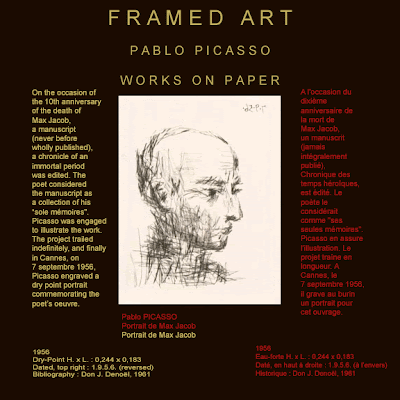 Yesterday, I received an email from a friend with a link to David Hockney's website...which is very cool, and here it is for your visual enjoyment. Mr. Hockney is a contemporary artist with works covering a wide range from drawings, paintings to stage and theatre design.
Yesterday, I received an email from a friend with a link to David Hockney's website...which is very cool, and here it is for your visual enjoyment. Mr. Hockney is a contemporary artist with works covering a wide range from drawings, paintings to stage and theatre design.The best part of the home page of Mr. Hockney's website is the copyright warning, which brings us some of the things related to fine art editions, copies and the values placed on them.
Without getting into the details of copyright law, the big deal about copyright is that the image belongs to the creator, in this case, Mr. Hockney, and can't be used by anyone for any reason (technically, I shouldn't use it here, so I'll write to Mr. Hockney and ask his permission, if he declines, I'll remove the image). I used the image because it links to his site, which is the best artist's site I've ever seen. It's full of information about Mr. Hockney, his full biography even contains details about his parents and education. His gallery of works includes singular (one of a kind) works and editions, and all the works are fully described in terms of title, medium, and size. The edition works are described in terms of edition.
What is an edition? My favorite online source for quick info is Wikipedia, and it defines 'edition' as 'a number of prints struck from one plate, usually at the same point in time. ... [an edition] may be a limited edition, with a fixed number of impressions produced on the understanding that no further impressions (copies) will be produced later, or an open edition limited only by the number that can be sold or produced before the plate wears. Most modern artists produce only limited editions, normally signed by the artist in pencil, and numbered as say 67/100 to show the unique number of that impression and the total edition size.' Prior to the 20th century, and modern copy machines and digital print tools, artworks were reproduced by methods such as lithography, mezzotint, and etching, among others. The works were copied under the instruction of the artist, generally on the belief that they were worthy of reproduction and were a good source of supplemental income for the artist.
A numbering system for editions was developed to show how many prints were developed, with the belief that the artist would not print more than the number stated. For example, Mr. Hockney's work, Black Plant on Table, 1986, was printed in a limited edition of 30 (the actual work is a set of 6 printed pages arranged in a fixed order). Modern artists such as Roy Lichtenstein, Pablo Picasso, Henri Matisse, and
 countless others printed favored images using this system. In some cases, the artists or their publishers didn't number their prints, relying on a finite limit to the print edition. For example, Pablo Picasso created a dry-point portrait of Max Jacob (image, left) to illustrate his works, which were printed and never numbered, leaving the question of the work's authenticity up to provenance.
countless others printed favored images using this system. In some cases, the artists or their publishers didn't number their prints, relying on a finite limit to the print edition. For example, Pablo Picasso created a dry-point portrait of Max Jacob (image, left) to illustrate his works, which were printed and never numbered, leaving the question of the work's authenticity up to provenance.The problem of authenticity is huge with regard to prints. As a result, all kinds of rules and specialties have developed to prove the work as authentic. Probably the easiest rule to remember is whether the work is signed, as a true signature is the first mark of authenticity for any artwork. That kind of proof adds value to any work, and especially to copies, or editions.
Alright, this could go on almost forever, it's such a long topic, so I'll end this note for now as follows: the concept of editions is good for the general public and for the artist, for the same economical reasons. The problem with it is value and worth. Next edition blog, I'll discuss the different numbering systems. It's dry stuff, so I don't expect you to hold your breath - and in case you can't wait for the blog to come out (it's dry to write too), send me an email - micaela@micaela.com - and let me know how I can help you!


